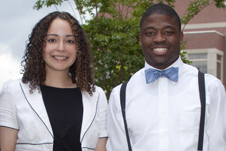Bridge students' achievements honored


By Ron Hartung
The latest – and largest – class of Bridge students was toasted at a May 15 luncheon, on the eve of their graduating with a master’s in biomedical sciences. The 12 students, two more than last year, heard Dean John Fogarty exclaim that they’re the students he brags about when he speaks to community groups. “You,” he said, “really are the mission of the College of Medicine.”
That mission includes service to elder, rural, minority and underserved populations. The Bridge Program plays a key role by providing a bridge into medical school for hand-picked students – those whose characteristics make them good candidates for practicing primary care with underserved or minority patients in rural or inner-city communities. Often the students come from such communities themselves and had not considered medical school as an option.
From the start, Bridge has seemed like a smart idea. But as the years go by, the evidence of just how smart keeps mounting.
Associate Dean for Medical Education Lynn Romrell, Ph.D., said that of the 38 Bridge graduates who have been through medical school, all but one have graduated. So Bridge grads are more likely to finish – plus they’re more likely to enter primary care, serve the underserved and become the physicians that Florida needs most.
“This program is the opportunity of a lifetime,” said Bridge grad Adam Baptiste, who previously worked for the College of Medicine's Department of Outreach and Advising. “Working alongside M.D.’s, Ed.D’s, Ph.D’s, master’s and medical students has really prepared me to take it to another level professionally. I am more sure than ever that I will become a physician.”
Each year at graduation, before the medical students receive their diplomas, the Bridge students receive their master’s diplomas. Ten days later, they return as first-year medical students.
Romrell said the rest of the Class of 2016 will look upon these Bridge grads as valuable, experienced resources. As Fogarty said, “You are clearly ready to be medical students.”
One by one during the luncheon, each of the six women and six men stood before top-ranking deans, department heads, mentors, Bridge leaders and fellow students to describe what they had discovered during their research projects in the past year. Here are their names, project titles and faculty advisors:
• Adam Baptiste, “The Health Literacy Profile of Patients Seen at Tallahassee Memorial Hospital’s Transitional Care Center” (Gail Bellamy, Ph.D.).
• Daniel Bernabe, “Dementia Caregiver Problem Inventory: Initial Evaluation of Problem Frequency and Coder Agreement” (Rob Glueckauf, Ph.D.).
• Cashana Betterly, “Effect of Mental Health Interventions on Uninsured Minority Patients: A qualitative study” (José E. Rodríguez, M.D.).
• Alejandro Chavarriaga, “Prevalence of Stunting in the Rural Community of Los Cedros in Nicaragua” (Daniel Van Durme, M.D.).
• Gregorie Elie, “Music Listening and Anxiety in Dysphagia” (Gerry Maitland, M.D.).
• Marielys Figueroa-Sierra (pictured above), “interRAI Contact Assessment in Transitional Care” (Niharika Suchak, MBBS).
• Claras Leandre, “The Health Literacy Profile of Patients Seen at Tallahassee Memorial Hospital’s Transitional Care Center” (Gail Bellamy, Ph.D.).
• Maxim Olivier, “The Relationship Between Physical Activity and Cardiovascular Risk Factors in Midlife and Older Blacks” (Penny Ralston, Ph.D.).
• Makandall Saint Eloi (pictured above), “Describing Racial and Ethnic Differences, Among Patients Potentially Identified as Needing or not Needing Secondary Services, as Determined by the interRAI Contact Assessment” (Niharika Suchak, MBBS).
• Robert Solomon, “Does Providing Blood Pressure Cuffs Improve Home Blood Pressure Assessment Among Underserved Patients with Hypertension?” (Kendall Campbell, M.D.).
• Taleia Spence, “Type 1 Diabetes Report Card: How Well Do Caregivers and Children Perform?” (Kim Driscoll, Ph.D.).
• Kadijo Wade, “Dietary Calcium Consumption and CVD Risk Factors in Midlife and Older African-American Women” (Penny Ralston, Ph.D.).

